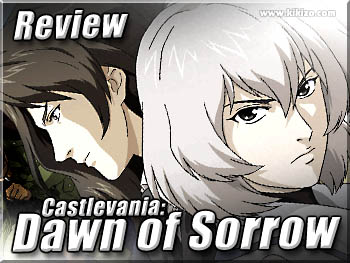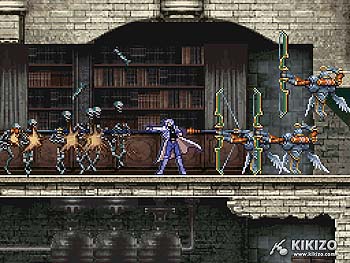Castlevania: Dawn of Sorrow
If it ain't broke, don't fix it. These were our first thoughts on playing Castlevania DS - but did it all turn our OK or what? Find out in our detailed review.
| Version DS | Developer Konami | Publisher Konami | Genre Adventure |
||||
By Heidi Kemps
Castlevania: Dawn of Sorrow is the latest installment in Konami's much-beloved Castlevania franchise, and the series' first foray on the Nintendo DS. For me, it is the very first "must-have" DS title for me - sure, Kirby and Meteos are fantastic, but there's something special about the 2D Castlevania games that makes them positively irresistable.

Maybe it's the years of memories associated with the series, maybe it's yearning for a genre that is sadly underrepresented these days... or maybe it's just love for really, really good games. (Most likely a mix of all three, I'd say). Koji Igarashi once agan assumes the director's chair for this outing, and after his two disappointing 3D efforts (PS2 Castlevania and Nanobreaker), it's nice to see him make a glorious return to doing what he does well.
Perhaps there's a double meaning to "return" in that sentence, since Dawn of Sorrow is one of the very rare direct sequels in Castlevania history. Rather than introducing a new lead character, Dawn of Sorrow takes place one year after the events of Aria of Sorrow, and puts us once again in control of Souma Kurusu. All the familiar faces from the previous game put in appearances, including his girlfriend Mina, "rival" Julius Belmont, Genya Arikado, Yoko Belnades, and Hammer (who seems to have developed a severe case of unrequited love for Miss Belnades).
One thing that sadly didn't return is the gorgeous Ayano Kojima design and illustration of previous games - instead, Dawn's character representations are drawn in stereotypical anime style. (Accompanying the designs is an intro movie that may as well be titled World's Most Generic Anime Opening.)
If you've played through Symphony of the Night or any of the GBA Castlevania games, you should have an idea of what to expect here. But for those of you who have unfortunately missed these titles, the gameplay can best be summarized as a 2-D scrolling action/adventure game with RPG elements. (Wow, that's a mouthful...) You are presented with a humongous castle to explore filled with hidden rooms, traps, enemies, and puzzles. Story scenes and dialogue are interspersed throughout, and defeating certain enemies or reaching certain goals will net you special items and abilities required to proceed in the game.
Speaking of which, the bosses in Dawn of Sorrow deserve special attention. the added power of the DS over the GBA allows the game to give us some spectacular and creative boss fights. Not only do the bosses look fantastic, but they are exceptionally well designed, resulting in some very unique and challenging battles that harken back to the times of pure action Castlevania.
It's not just the bosses, either - the graphics in Aria of Sorrow are leaps and bounds ahead of all the GBA games, and perhaps even better than the eternally beloved Symphony of the Night. Everything is well drawn and animated, with several enemies and backdrops being made from multiple sprites and even texture-mapped polygons. The music and sound is also impressive; Characters have lots and lots of voice samples (done by a few notable Japanese voice actors), and the instrumentation of the music is the best I've yet heard on the DS. (Be sure and listen to it through headphones - the DS speakers don't do this game justice!)
So how does the game use the extra abilities of the DS? The biggest and most useful addition is the use of the top screen for information. By pressing the SELECT button, you can easily toggle between the castle map and a status screen displaying Souma's strength and details on the enemies he is currently fighting against. The more hyped but less successful feature is the magic seals. Throughout the game, Souma learns special magic seals that must be drawn at the end of a boss battle in order to seal away a boss.
These are patterns drawn on the screen with the DS stylus. If you fail in drawing the pattern correctly, the boss will regain some HP and you'll have to continue fighting until you get another chance to draw the seal again. The sub-menu has an option that allows you to practice drawing the seals, but overall the system is really more of a nuisance than anything. It's frustating to beat a difficult boss, only to have to continue fighting because your hand slipped while drawing. The whole idea of the Magic Seals reeks of a design meeting where somebody said, "Guys, this system's got a touch screen. Can anyone here figure out what we can do with it so it looks like we're taking advantage of all the console's capabilities?"
So instead of fixing things that weren't broken (like we saw in the recent 3D PS2 outing), IGA has given us more of the 2D exploration and combat that we have come to love, and has made use of the dual screens to great effect. The famous catchphrase, however, lacks a second part - and one I believe should be equally important when creating games: "build upon the foundation instead."
This is exactly what the original Aria of Sorrow did. AoS took the formula that had been used successfully in Symphony of the Night, Circle of the Moon, and Harmony of Dissonance, and further refined it with a unique soul-collecting system. Using the souls of enemies you defeated would grant Souma new abilities and attacks, adding an entirely new dimension to combat and giving players extra enjoyment from collecting and trading. Adding to this was one of the most interesting and enjoyable stories to ever grace the series, including a shocking twist that turned Castlevania convention on its head. These factors contributed to make Aria of Sorrow one of the best - if not THE best - installments in the "new-style" Castlevania mould.
It is here, however, that Dawn of Sorrow falters in comparison to its predecessor. While Aria introduced fresh new gameplay elements into an established series, Dawn simply reuses all of the same systems of the previous title with only minor refinements. While the soul collecting of Aria was new and different, it's "been there, done that" with Dawn. Certainly the soul fusion system to power your weapons is new, but it hardly feels revolutionary - it's just another way to obtain weapons.
The story, too, suffers from this same feeling. Aria of Sorrow's story was fantastic, complete with the best. plot twist. EVER. (imagine this being said in Comic Book Guy voice for the full effect.) but most importantly, it had an ENDING, a conclusion that wrapped everything up neatly. There was simply no real need to drag out Souma and company again to add onto the story, and as a result, the game's plot feels dull, hackneyed, and worst of all, unneccessary. It's like the direct-to-video sequel of a blockbuster movie - they never really intended a sequel, but hey, it did well, so why not try to milk some more out of it?
This is perhaps the sole major disappointment of Dawn of Sorrow - despite its technical excellence, there's really nothing new here. The game is still fantastic, there's no doubt about that, but it just doesn't inspire the sense of satisfaction that Symphony of the Night and Aria of Sorrow did.
Perhaps to try and make up for these faults, though, Dawn of Sorrow offers the best "extras" of any Castlevania to date. Previous Castlevania installments have primarily just given you extra characters to play as after finishing the game. However, these characters tend to either be ineffective or terribly overpowered (see Maria in the Saturn Symphony of the Night port), and their games are devoid of any sort of story or plot progression.
Dawn of Sorrow, however, provides not only a boss rush and a hard mode, but an custom "Enemy Room" (where you place defeated enemies and try to beat them boss-rush style) and a nostalgia-laden bonus game mode, complete with an alternate storyline and ending. I won't reveal any more than that, since I don't want to spoil the game for you, but I can say that you definitely want to get the "worst" ending at least once to unlock it.
All in all, Dawn of Sorrow does disappoint in a few areas, but it's still leaps and bounds above most of the recent portable releases. It's probably the best game yet released for the DS, and it's definitely a solid contender for the best portable game of the year. No DS owner should be without this game in their collection.
| ||||||||||||
|
| Video Coverage (Latest Videos & Video FAQ) | |||
| PLEASE DO NOT DIRECT LINK TO ANY MEDIA FILE ON KIKIZO | |||
| Description | Dur. | Size | Details |
|
Castlevania: Dawn of Sorrow Gameplay footage (Konami) |
0.35m | 5MB | DF, SD, 30 640x480 1.5Mbps |
|
Castlevania: Dawn of Sorrow Includes shakycam footage (640x380, 1.7Mbps, 25fps) |
1.16m | 14.9 MB | WMV |































 Satoru Iwata Video Interview - the late Nintendo president spoke with Kikizo in 2004 as 'Nintendo Revolution' loomed.
Satoru Iwata Video Interview - the late Nintendo president spoke with Kikizo in 2004 as 'Nintendo Revolution' loomed. Kaz Hirai Video Interview - the first of Kikizo's interviews with the man who went on to become global head of Sony.
Kaz Hirai Video Interview - the first of Kikizo's interviews with the man who went on to become global head of Sony. Ed Fries Video Interview - one of Xbox's founders discusses an epic journey from Excel to Xbox.
Ed Fries Video Interview - one of Xbox's founders discusses an epic journey from Excel to Xbox. Yu Suzuki, the Kikizo Interview - we spend time with one of gaming's most revered creators.
Yu Suzuki, the Kikizo Interview - we spend time with one of gaming's most revered creators. Tetris - The Making of an Icon: Alexey Pajitnov and Henk Rogers reveal the fascinating story behind Tetris
Tetris - The Making of an Icon: Alexey Pajitnov and Henk Rogers reveal the fascinating story behind Tetris Rare founders, Chris and Tim Stamper - their only interview? Genuinely 'rare' sit down with founders of the legendary studio.
Rare founders, Chris and Tim Stamper - their only interview? Genuinely 'rare' sit down with founders of the legendary studio. The History of First-Person Shooters - a retrospective, from Maze War to Modern Warfare
The History of First-Person Shooters - a retrospective, from Maze War to Modern Warfare